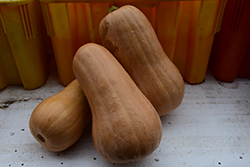Fri & Sat 8am - 8pm
Sun 8am - 7pm
Anytown, USA 12345
fax: 261.787.0463
e-mail: info@successgc.com


Plant Finder

Height: 12 inches
Spacing: 4 feet
Sunlight:
![]()
Hardiness Zone: (annual)
Group/Class: Winter Squash
Description:
Low maintenance and easy to grow, this selection is perfect for full sun gardens; produces 12" long squashes on long vines; tan exteriors lead to deep orange flesh with a beautiful sweet and nutty flavor that is great for roasting, soups, stews and baking
Edible Qualities
Butternut Squash is an annual vegetable plant that is typically grown for its edible qualities. It produces dark green oblong fruit mottled with light green and orange flesh which are typically harvested when mature. The fruit will often fade to tan over time. The fruits have a sweet taste.
The fruit are most often used in the following ways:
- Cooking
- Baking
- Freezing
Planting & Growing
Butternut Squash will grow to be about 12 inches tall at maturity, with a spread of 8 feet. When planted in rows, individual plants should be spaced approximately 4 feet apart. This vegetable plant is an annual, which means that it will grow for one season in your garden and then die after producing a crop.
This plant is typically grown in a designated vegetable garden. It should only be grown in full sunlight. It does best in average to evenly moist conditions, but will not tolerate standing water. It is not particular as to soil type or pH. It is somewhat tolerant of urban pollution. Consider applying a thick mulch around the root zone over the growing season to conserve soil moisture. This is a selected variety of a species not originally from North America.; however, as a cultivated variety, be aware that it may be subject to certain restrictions or prohibitions on propagation.
